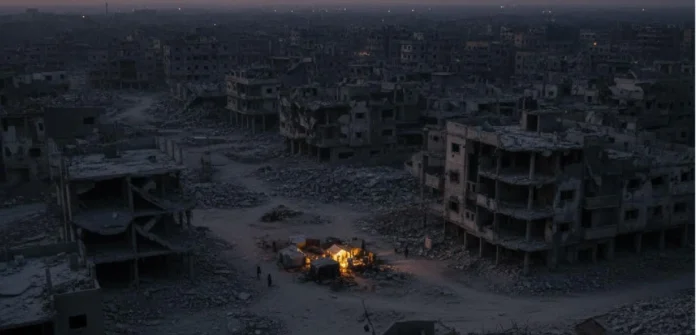By Annunthra Rangan
Two years and two days after Gaza was first engulfed in flames, the world is witnessing what may be the first flicker of an ending. Israel and Hamas have agreed to Phase One of a 20-point peace plan, halting—for now—a war that has reduced one of the world’s most densely populated regions to rubble.
Under the agreement, Hamas will release 20 Israeli hostages in exchange for 2,000 Palestinian prisoners, many of whom were detained without charge under Israel’s controversial administrative detention laws. The exchange—a symbolic gesture amid unimaginable suffering—is to take place within 72 hours of implementation.
Donald Trump, who helped broker the deal alongside Egyptian and Qatari mediators, called it “the biggest breakthrough in months”. For Gaza’s two million residents, the truce feels less like triumph and more like temporary relief—a fragile pause in a relentless cycle of siege, starvation, and death.
The war began on October 7, 2023, when Hamas launched a deadly assault on southern Israel, killing over 1,200 and taking 251 hostages. Israel responded with what many now describe as a campaign of collective punishment—an onslaught that destroyed hospitals, flattened entire neighbourhoods, and displaced nearly 80 percent of Gaza’s population.
By the end of 2024, Gaza had become a landscape erased. Satellite images revealed a coastline of rubble. The UN declared the enclave “uninhabitable”. Over 36,000 Palestinians, mostly women and children, were dead. Thousands more remained missing beneath the ruins.
Israel defended its actions as self-defense; the world, increasingly, saw genocide. Even long-time allies grew uneasy as images of lifeless children filled social feeds and streets around the world erupted in protest.
The first phase of the new agreement includes:
- A three-week ceasefire across Gaza.
- The release of hostages and prisoners on both sides.
- Partial Israeli withdrawal from northern Gaza.
- The opening of key crossings, including Rafah, for humanitarian aid.
- Limited return of displaced civilians to designated “safe zones”.
Humanitarian convoys, coordinated through Egypt and the UN, will be permitted to deliver food, water, and medicine—a lifeline Gaza hasn’t had in months.
Still, optimism is scarce. Earlier ceasefires in 2023 and 2025 collapsed within days. This one feels different only because both sides are exhausted.
Inside Israel, protests have surged, with families of hostages demanding an end to the war. Prime Minister Benjamin Netanyahu faces revolt within his own ranks, while Hamas, weakened militarily, is desperate for a reprieve.
The asymmetry of the exchange—20 hostages for 2,000 prisoners—underscores Gaza’s grim reality. Critics say it reflects not generosity, but the vast scale of Palestinian incarceration. Many of the bodies returned by Israel bore marks of torture—a grim reminder of the human cost buried behind numbers.
Inside Gaza, the ceasefire’s silence feels almost alien. Over 1.8 million people remain displaced, sheltering in tents and ruins. Hospitals run on fumes; 97 percent of Gaza’s water is undrinkable. Even in pause, the trauma persists.
One Gazan’s words, posted to social media after the ceasefire, capture the collective dread: “We went to sleep last night. There was a thud—a cat knocked something over—and 46 people in the tent woke up screaming. We thought it was another bomb. The fear doesn’t end. It just hides in the dark.” For Gazans, survival itself has become resistance. The truce means a night without bombs, not an end to war.
Diplomats hint at a “second phase” that could extend the ceasefire and pave the way for rebuilding under international supervision. But mistrust runs deep: Israel insists Hamas must disarm; Hamas demands a full withdrawal and the lifting of the blockade. And so, even this fragile peace remains haunted by the inevitability of collapse.
Beyond Gaza, the conflict has reshaped geopolitics. The US seeks credibility, Egypt stability, and Qatar influence. Yet the moral question remains unresolved. Governments that call themselves defenders of human rights have watched Gaza burn and called it self-defence.
In the ashes of Gaza lies a truth too many refuse to name: this was not merely a political failure—it was a moral one.
Until the world finds the courage to call genocide by its name, and to hold power accountable, peace will remain what it has always been in Gaza — a pause between two wars.
—The writer is a Senior Research Officer at Chennai Centre for China Studies. Her research interests constitute China-WANA (West Asia and North Africa) relations and human rights


